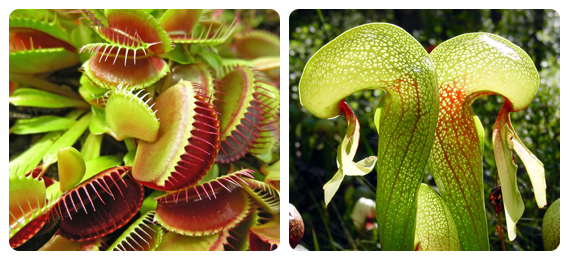
What are carnivorous plants? Do you know how these plants hunt or if they are capable of attacking humans? Find out how to identify and tame them into houseplants now.
What Are Carnivorous Plants?
Humans, who consume only plant-based food are considered vegetarians but are plants really vegetarians? The nutrition requirements of wild plants and trees are met by decomposition. Soil decomposes dead matter, converts it to nutrients to feed the plants. Thus, technically all plants are carnivorous in nature.
In reality, plants that are capable of hunting their food and digesting it without any help from decomposed soil are known as carnivorous plants.
Which Among Following Is a Carnivorous Plant?
- A. Green Apple
- B. Custard Apple
- C. Pineapple
- D. All of the Above
Where Are Carnivorous Plants Found?
Carnivorous plants grow in bogs in clusters. Bogs are low in nutrition and highly acidic. The quality of the soil creates the need for excess nutrition apart from photosynthesis. Thus, carnivorous plants emerged. They can be found across the world except in Antarctica.
Carnivorous plants can be grown at home with other plants. Gardeners have been successful in replicating their natural habitats. Venus flytraps are the most common house plants.
How Many Carnivorous Plants Are There?
There are around 630 known species of carnivorous plants in the wild. Most of these plants like sundews and pineapples are edible carnivorous plants.
Carnivorous plants receive very little energy from photosynthesis. Therefore, small plants rely on insects while the larger ones on small animals, birds, and fish for their nutritional needs. They usually hunt through a trap and kill method. They have special mechanisms that help them differentiate between prey and pollinators.
The flowers are usually situated high above with sweet smells attracting pollinators while the traps are low on the ground with a different odor to attract crawling food.
What do Carnivorous Plants Eat?
Can carnivorous plants eat humans? From the smallest to the largest, all carnivorous plants can digest human flesh but they are incapable of attacking us. Meaning, you can’t get attacked or killed by a carnivorous plant but they can chew off your fingers if you were to stick them in.
Nepenthes Rajah, a six-meter-long plant, is the largest carnivorous plant known to man. They are an endangered species that rely on ants and mammals for food.
Types of Carnivorous Plants
Drosera, Dionaea muscipula, Nepenthes, and Utricularia are the common types of carnivorous plants. They can also be classified based on five special anatomical adaptations that help them survive.
1. Pitcher Plants
“Pitcher plants feature modified leaves forming cup-like traps. These traps hold sweet-smelling nectar to lure insects. Upon landing on the rim, insects fall into the pitcher, where they become ensnared in digestive fluids at the base.”
2. Sundews
“Sundews possess sticky tentacles enveloping their leaves, adorned with glistening droplets akin to dew. Upon an insect’s landing, it gets ensnared. Subsequently, the sundew gradually wraps its tentacles around the insect, entrapping and absorbing its nutrients.”
3.Venus Flytrap
The Venus Flytrap stands out as a widely recognized carnivorous plant, characterized by hinged leaves that swiftly close upon contact with trigger hairs inside the trap. Following closure, the Venus Flytrap gradually digests the trapped insect.
4. Bladderworts
Bladderworts, aquatic carnivorous plants, feature modified leaves forming small bladders equipped with trapdoors. These bladders create a vacuum, drawing in small organisms such as plankton and water fleas. Upon capture, the trapdoor seals, allowing the bladderwort to digest its prey.
5. Brocchinia
“Brocchinia, epiphytic carnivorous plants, thrive by growing on other plants. They feature a rosette of leaves forming a central tank, which traps water and decomposing organic material. Insects lured by this matter can get ensnared in the tank, where they are subsequently digested by the Brocchinia.”
6. Byblis
Byblis, commonly referred to as rainbow plants, hail from Australia and are carnivorous by nature. Adorned with sticky leaves adorned with vibrant, rainbow-colored hairs, they allure insects that subsequently become ensnared and digested by the plant.